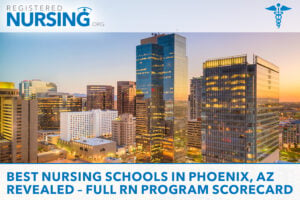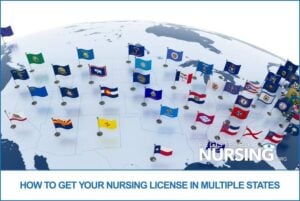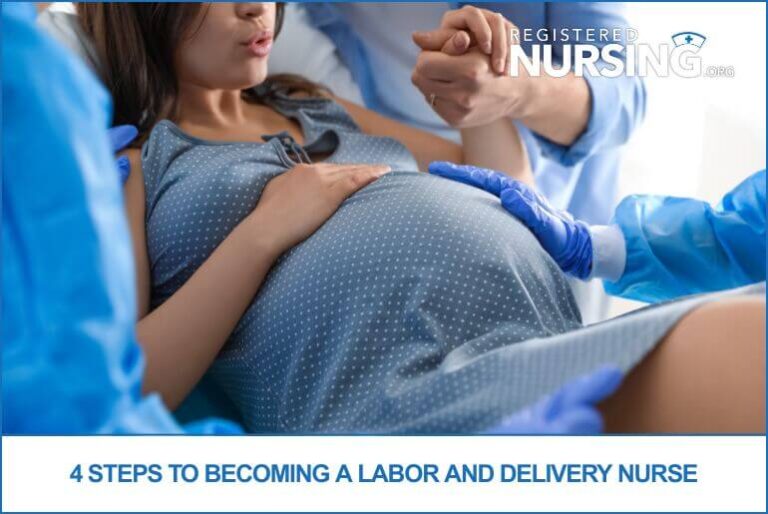Labor and delivery nurses play a critical role in one of the most transformative moments in a patient's life: childbirth. According to the U.S. Bureau of Labor Statistics, employment for registered nurses is projected to grow by 6% from 2022 to 2032, with maternal and neonatal care continuing to be an essential specialty. The demand for compassionate, highly skilled labor and delivery (L&D) nurses is on the rise as more families seek high-quality, personalized birth experiences that prioritize safety, comfort, and emotional support.
Every birth is different, and every family brings its own story. As a labor and delivery nurse, you'll be at the heart of these experiences, providing expert care, reassurance, and strength to patients at their most vulnerable moments. From closely monitoring fetal health to coaching patients through contractions, your presence will make a profound difference in countless lives. This career combines technical expertise with deep empathy, making it one of the most dynamic and rewarding specialties in nursing.
If you’re passionate about women’s health, newborn care, and want to be a calm, capable presence during life's most profound events, becoming a labor and delivery nurse could be the perfect path for you. This guide will walk you through the four essential steps to launching—and thriving in—a fulfilling and lifelong career as a labor and delivery nurse.
Step 1: Become a Registered Nurse (RN)
Before you can specialize in labor and delivery, you'll need to become a licensed Registered Nurse (RN). This foundational step ensures you have the medical knowledge and clinical skills required for any nursing role and prepares you for the challenges of a fast-paced, high-responsibility work environment like labor and delivery.
Choose an RN Program: ADN vs. BSN
Most aspiring nurses choose between an Associate Degree in Nursing (ADN) and a Bachelor of Science in Nursing (BSN). While both paths qualify you to take the NCLEX-RN exam, a BSN is often preferred by employers—especially in specialty units like L&D. A BSN also opens the door to leadership opportunities and graduate education later in your career.
| Program Type | Typical Duration | Tuition Range | Focus Areas |
|---|---|---|---|
| ADN | 18–24 months | $6,000–$20,000 | Core nursing skills, basic clinicals |
| BSN | 3–4 years | $20,000–$100,000 | Advanced clinicals, leadership, community health |
Many BSN programs include electives or clinical rotations in obstetrics, neonatal care, and women's health, which can give you a competitive edge when applying to L&D positions. Use tools from organizations like the American Association of Colleges of Nursing (AACN) to compare BSN program offerings, or browse nursing schools by state to find accredited programs near you.
Pass the NCLEX-RN Exam
After completing your nursing program, you must pass the NCLEX-RN exam administered by the National Council of State Boards of Nursing (NCSBN). This comprehensive exam tests your ability to think critically and apply nursing knowledge in real-world scenarios. Consider NCLEX prep courses or study groups to ensure you're fully prepared.
Learn more about what to expect and how to prepare using our NCLEX-RN guide.
Step 2: Gain Clinical Experience
Even after earning your RN license, you likely won't step directly into a labor and delivery unit. Gaining general clinical experience builds the foundation you'll need to succeed in high-stakes environments like L&D, where critical thinking, adaptability, and quick decision-making are essential.
Start in Med-Surg or Mother-Baby Units
Many nurses begin their careers in medical-surgical or postpartum (mother-baby) units. These settings allow you to strengthen core competencies such as patient assessment, communication, IV therapy, and emergency response.
For instance, managing post-op surgical patients helps hone the skills necessary for monitoring postpartum recovery, while caring for new mothers and infants provides a direct bridge to L&D. Nurses in these units often develop a well-rounded clinical judgment that proves invaluable in labor and delivery scenarios.
If you’re set on L&D, look for hospitals that allow cross-training or float pool assignments that include OB units. This can provide a strategic entry point while allowing you to demonstrate your interest and commitment to the specialty.
Volunteer or Shadow Labor and Delivery Nurses
If direct employment in L&D isn’t available right away, consider shadowing experienced nurses or volunteering in related hospital departments. Observing an L&D nurse firsthand can help you better understand the demands of the role—from interpreting fetal monitors to advocating for patient-centered birth plans.
Volunteering also allows you to build relationships with nursing staff and managers, increasing your chances of being considered when an L&D position opens. Keep your resume up to date and highlight any relevant experiences in maternal or neonatal care.
Step 3: Specialize in Labor and Delivery
Once you've gained sufficient clinical experience, you can begin the process of transitioning into a labor and delivery role. This is where your career truly takes shape and you begin to develop expertise in the field of maternal and infant care.
Transition into an L&D Role
Many hospitals offer nurse residency or specialty training programs specifically for labor and delivery. These structured programs typically include classroom instruction, hands-on simulation, and one-on-one mentorship with seasoned nurses.
For example, a 12-week L&D residency might include modules on obstetric emergencies, labor progression, cesarean delivery protocols, and fetal heart rate interpretation. These programs are invaluable for building confidence and competency in a highly specialized area.
If your facility doesn't offer formal training, ask about opportunities to precept with an experienced L&D nurse or attend continuing education workshops on obstetrics. Learn more about nurse residency programs and how they can support your transition into specialty care.
Earn Certifications to Boost Your Credentials
Earning certifications shows initiative and enhances your credibility as a labor and delivery nurse. These credentials not only improve your clinical skills but can also increase your chances of promotion and salary advancement.
| Certification | Credentialing Body | Key Focus |
|---|---|---|
| RNC-OB | National Certification Corporation (NCC) | Inpatient obstetric nursing |
| C-EFM | NCC | Electronic fetal monitoring |
| NRP | American Academy of Pediatrics (AAP) | Neonatal resuscitation |
Some hospitals may cover the cost of certification exams and preparation materials, so check with your employer about available support. Maintaining certification through continuing education also keeps you current with best practices in L&D nursing. Visit our guide to nursing certifications for more information on what’s available and how to qualify.
Step 4: Advance and Grow in Your Career
Labor and delivery nursing is a dynamic field with numerous opportunities for advancement. Whether you're interested in leadership, education, or further specialization, ongoing growth is essential to both professional fulfillment and improved patient care.
Explore Advanced Roles
As you gain experience in L&D, you may choose to pursue advanced roles such as charge nurse, nurse manager, or clinical educator. These positions typically involve coordinating team efforts, mentoring new nurses, and overseeing the implementation of quality improvement initiatives.
If you're drawn to patient advocacy and holistic care, you might consider becoming a Certified Nurse Midwife (CNM). This role requires a Master of Science in Nursing (MSN) or Doctor of Nursing Practice (DNP) and allows you to provide prenatal, delivery, and postpartum care independently or in collaboration with OB/GYNs. Learn more from the American College of Nurse-Midwives (ACNM) and explore advanced nursing roles through our nursing specialties directory.
Advanced practice roles not only offer increased responsibility but also significantly higher earning potential and greater autonomy in patient care decisions.
Stay Active in the Professional Community
Professional organizations are a great way to stay connected, informed, and inspired throughout your career. Groups like the Association of Women’s Health, Obstetric and Neonatal Nurses (AWHONN) offer access to the latest research, policy updates, and evidence-based practice guidelines.
Engaging with your peers through conferences, webinars, and forums can help you stay on top of emerging trends in labor and delivery, such as trauma-informed birth care or advances in fetal monitoring technology. Active membership also strengthens your professional network and can lead to mentorship or job opportunities.
Start Your Journey Today
Becoming a labor and delivery nurse is a meaningful, challenging, and empowering career path. Each step—from earning your RN license to pursuing advanced certifications—brings you closer to a role where your skills and compassion directly impact lives at their beginning.
Whether you’re just starting out or seeking a new direction in your nursing journey, the labor and delivery specialty offers personal satisfaction, professional growth, and the joy of helping families welcome new life. By following these four steps—educating yourself, gaining experience, specializing in maternal care, and continuously advancing—you'll be prepared to make a lasting difference.
Ready to take the next step? Explore accredited nursing programs, licensure requirements by state, and professional certification opportunities and take confident strides toward your future in labor and delivery nursing.
Sources
- U.S. Bureau of Labor Statistics – Registered Nurses
- American Association of Colleges of Nursing (AACN)
- National Council of State Boards of Nursing – NCLEX
- National Certification Corporation (NCC)
- American Academy of Pediatrics (AAP)
- American College of Nurse-Midwives (ACNM)
- Association of Women’s Health, Obstetric and Neonatal Nurses (AWHONN)
Latest Articles & Guides
One of the keys to success as a registered nurse is embracing lifelong learning. Our articles and guides address hot topics and current events in nursing, from education to career mobility and beyond. No matter where you are on your nursing journey, there’s an article to help you build your knowledge base.
Browse our latest articles, curated specifically for modern nurses.




